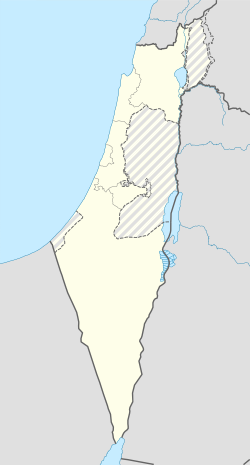Classical antiquity
Along with several other sites, Bi'ina was proposed as the location of ancient Beth-Anath mentioned in Egyptian and biblical texts. [4] [Note 1] Archaeological evidence suggests that Bi'ina, though perhaps occupied in the Early Bronze Age, was no longer occupied in the Late Bronze Age. [7]
The old site of Bi'ina is thought to have been at the mound of Jelamet el-Bi'ina, less than a mile southeast of the present site of Bi'ina. [8] The word jélameh, meaning "hill, mound," is sometimes employed instead of tell .
Ottoman Empire
In 1517 Palestine was conquered by the Ottoman Empire from the Mamluks. Around this time, possibly as early as 1510, the Sufi sheikh Muhammad al-Asad had settled in the monastery of the village of Dayr al-Bi'ina (also called Dayr al-Khidr, the 'St. George La Beyne' of the Crusaders). Under order of the Ottoman sultan Selim I (r. 1512–1520), a major patron of the Sufis, the Christian inhabitants of Dayr al-Bi'ina were expelled from the village, so that eventually a significant Muslim settlement could be established there under the auspices of Muhammad al-Asad and his followers. Dayr al-Bi'ina was thereafter called Deir al-Asad after the sheikh and the expelled Christians established the village of Bi'ina at its present site, about 0.5 kilometers (0.31 mi) to the south of Dayr al-Bi'ina. According to local tradition, the present Christian inhabitants of Bi'ina are the descendants of the expelled Christians.
In 1596 Bi'ina was recorded in Ottoman tax registers as belonging to the nahiya (subdistrict) of Acre, part of Safed Sanjak. It had a population of 61 households; 46 Muslim and 15 Christian. The villagers paid a fixed tax rate of 25% on agricultural products, including wheat, barley, olives, cotton, goats or beehives, in addition to a press for grapes or olives; a total of 7,134 akçe. [10] [11]
By the early 18th century the Banu Zaydan (or Zayadina) family held sway in the Shaghur area and their future leader, Zahir al-Umar, played a prominent role defending Bi'ina from a taxation campaign by the Ottoman governor of Sidon at some point between 1713 and 1718. The event helped establish Zahir's good reputation with the area's inhabitants. By 1730, Zahir had gained control of Tiberias as its multazim (tax farmer) and within a few years moved to expand his domains. In 1740 Zahir besieged Bi'ina, by then a fortified village, but after failing to capture it, secured control of it by forming a pact with its headman, sealed by Zahir's marriage to the headman's daughter.
After Zahir was slain in an imperial Ottoman campaign against him, the new, Acre-based governor of Sidon, Jazzar Pasha, moved to eliminate Zaydani control in the Galilee. Zahir's son Ali posed the main challenge to Jazzar's rule in the region and controlled several fortified villages in the central and eastern Galilee, including Bi'ina. After a string of victories against Ali, Jazzar gained control of the area in 1776. A map from Napoleon's invasion of 1799, during Jazzar's rule, by Pierre Jacotin showed the place, named as "El Bena", [16] while in 1838, el Ba'neh was noted as Greek Christian village in the Esh-Shagur district, located between Safad, Acca and Tiberias. [17]
In 1875 Victor Guérin noted that the population was divided between Druze and Greek Orthodox Christians. He listed a mosque and a Greek church, both of which were built on the sites of older churches. [18] In the late 19th century, it was described as a village of 300 Muslims and 100 Christians, surrounded by olives and arable land. Water was supplied by a spring. [19] A sarcophagus was also seen lying outside the town. Lieutenant Kitchener of the Palestine Exploration Fund described the town under its name El-Baneh, and where he noted a spring and birket (reservoir). [19] A population list from about 1887 showed that B'aneh had 620 inhabitants; slightly more Muslims than Greek Catholic Christians. [20]
British Mandate
In the 1922 census of Palestine conducted by the British Mandate authorities, Al Ba'na had a population of 518; 311 Muslims and 207 Christians, [21] where all the Christians were Orthodox. [22] By the 1931 census the population had increased to 651; 441 Muslims and 210 Christians, in a total of 133 houses. [23]
In the 1945 statistics, Bi'ina had 830 inhabitants; 530 Muslims and 300 Christians. [24] They owned 14,839 dunams of land, while 57 dunams were public. [24] [25] 1,619 dunams were plantations and irrigable land, 5,543 used for cereals, [24] [26] while 57 dunams were built-up (urban) land. [24] [27]


